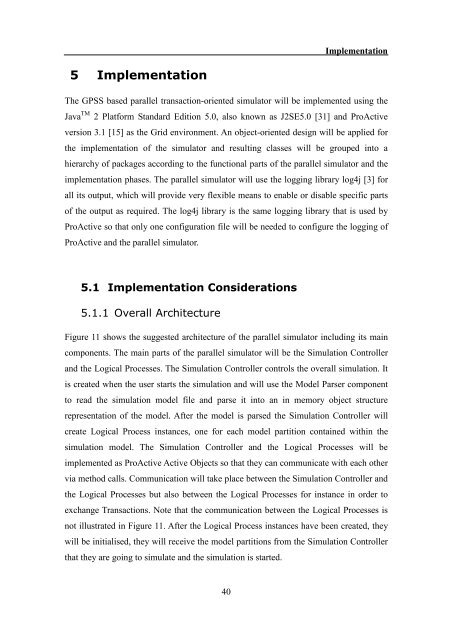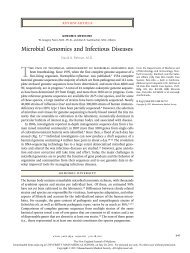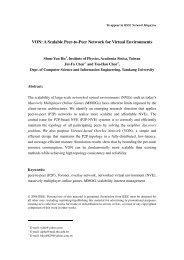3.1 MB - Evernote
3.1 MB - Evernote
3.1 MB - Evernote
Create successful ePaper yourself
Turn your PDF publications into a flip-book with our unique Google optimized e-Paper software.
5 Implementation<br />
40<br />
Implementation<br />
The GPSS based parallel transaction-oriented simulator will be implemented using the<br />
Java TM 2 Platform Standard Edition 5.0, also known as J2SE5.0 [31] and ProActive<br />
version <strong>3.1</strong> [15] as the Grid environment. An object-oriented design will be applied for<br />
the implementation of the simulator and resulting classes will be grouped into a<br />
hierarchy of packages according to the functional parts of the parallel simulator and the<br />
implementation phases. The parallel simulator will use the logging library log4j [3] for<br />
all its output, which will provide very flexible means to enable or disable specific parts<br />
of the output as required. The log4j library is the same logging library that is used by<br />
ProActive so that only one configuration file will be needed to configure the logging of<br />
ProActive and the parallel simulator.<br />
5.1 Implementation Considerations<br />
5.1.1 Overall Architecture<br />
Figure 11 shows the suggested architecture of the parallel simulator including its main<br />
components. The main parts of the parallel simulator will be the Simulation Controller<br />
and the Logical Processes. The Simulation Controller controls the overall simulation. It<br />
is created when the user starts the simulation and will use the Model Parser component<br />
to read the simulation model file and parse it into an in memory object structure<br />
representation of the model. After the model is parsed the Simulation Controller will<br />
create Logical Process instances, one for each model partition contained within the<br />
simulation model. The Simulation Controller and the Logical Processes will be<br />
implemented as ProActive Active Objects so that they can communicate with each other<br />
via method calls. Communication will take place between the Simulation Controller and<br />
the Logical Processes but also between the Logical Processes for instance in order to<br />
exchange Transactions. Note that the communication between the Logical Processes is<br />
not illustrated in Figure 11. After the Logical Process instances have been created, they<br />
will be initialised, they will receive the model partitions from the Simulation Controller<br />
that they are going to simulate and the simulation is started.
















